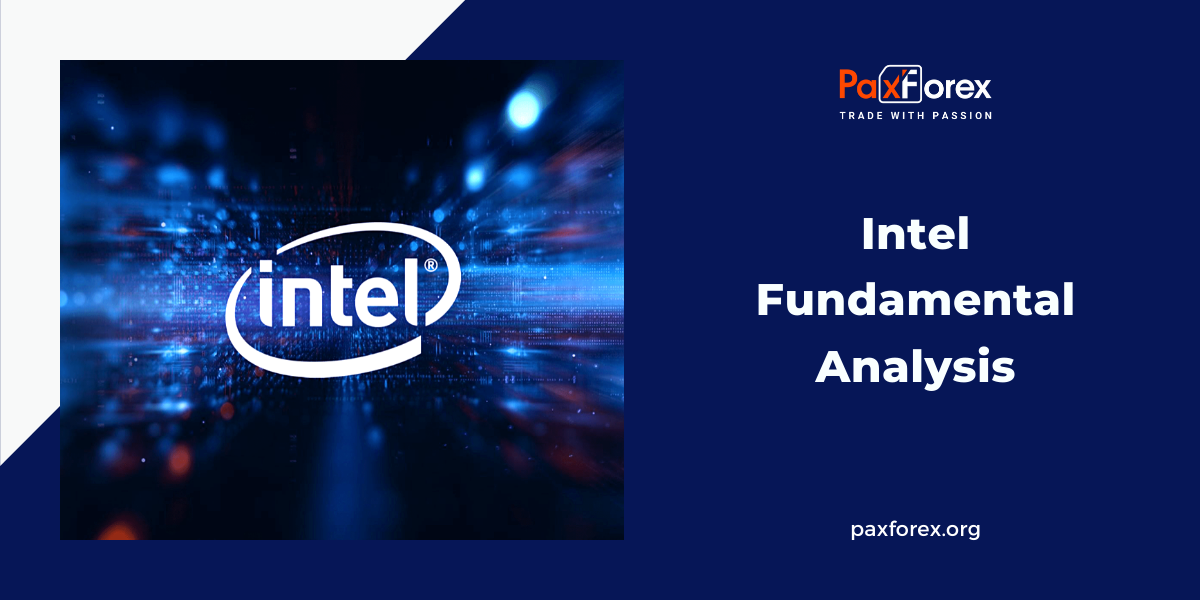
Source: PaxForex Premium Analytics Portal, Fundamental Insight
Intel had arguably one of the worst years in the history of the stock.
A component of the Dow Jones Industrial Average and one of the largest semiconductor companies in the world ended 2022 with earnings down 20% to $63.1 billion. For the year, the company lost $9.4 billion in free cash flow, and its stock price dropped nearly 50 percent. Even worse, Intel expects a loss in the first quarter of 2023 and forecasts a 40% year-over-year drop in revenue.
The chip maker is not entirely to blame for the weak performance. Inventory glut in the semiconductor industry, especially in PC chips, has also hit peers like Advanced Micro Devices and Micron Technology, and declining demand for PCs is also affecting performance. The chip sector is notoriously cyclical, and prices can fluctuate widely.
For several years, Intel has lagged behind its competitors, steadily losing market share to AMD. It is struggling to grow at a time when much of the sector is thriving, and the company's latest decision shows why this struggle is likely to continue.
After disappointing results last year, the company is cutting costs. It is laying off employees, cutting salaries for mid-level and above, reducing 401(k) contributions, and suspending quarterly performance bonuses, although annual performance bonuses will remain.
Given the company's recent performance, layoffs and pay cuts seem logical, but there is another area where savings would seem more natural. The company currently spends $6 billion a year on dividends, a common form of profit sharing. But there's a catch here. Intel is not profitable. Based on first-quarter projections and the broader crisis in the chipmaking sector, it doesn't look like the company will be monetarily profitable anytime soon, especially when it plans to invest up to $100 billion in new manufacturing facilities.
During a recent earnings call, company executives were asked about dividends. Here's what CFO David Zinsner responded:
"I would just say that the board, management, we take a very disciplined approach to our capital allocation strategy, and we're going to remain committed to a very prudent approach to capital allocation for owners. And we intend to maintain a competitive dividend."
Some investors may appreciate this commitment as Intel currently offers a significant dividend yield of 4.9 percent, but Intel's track record suggests otherwise, as the stock has gone nowhere in 20 years. It's also not the first time the company has prioritized dividends over fundamental business investments. Back in July, the company confirmed the size of the payout but said it would cut its capital spending by $4 billion, which would likely be covered by semiconductor factory production.
Intel's decision to prioritize dividends over salaries seems like a shareholder theory taken to an extreme.
Smart managers know that building a successful business starts with taking care of your employees, who in turn take care of their customers, who buy your product and thereby bring profits to investors. Continuing to pay dividends while the company loses nearly $10 billion a year and lags behind competitors is completely unreasonable. Intel's main competitor, AMD, doesn't even pay dividends, which puts Intel at an even greater competitive disadvantage as long as the company commits to paying the $6 billion a year it doesn't earn.
Intel is not about to lose money. It has about $28 billion in cash and short-term investments, but it has $42 billion in debt, and its cash balance is likely to be even more depleted in 2023.
Cutting salaries and taking away bonuses could also hurt employee morale and, in the long run, damage Intel's reputation in the workforce. Given the company's already weak position and its decision to prioritize shareholder compensation over business investment, its stock is likely to decline in the coming years.
As long as the price is above 27.00, follow the recommendations below:
- Time frame: D1
- Recommendation: long position
- Entry point: 28.17
- Take Profit 1: 31.00
- Take Profit 2: 34.00
Alternative scenario:
If the level of 27.00 is broken-down, follow the recommendations below:
- Time frame: D1
- Recommendation: short position
- Entry point: 27.00
- Take Profit 1: 25.00
- Take Profit 2: 23.00













